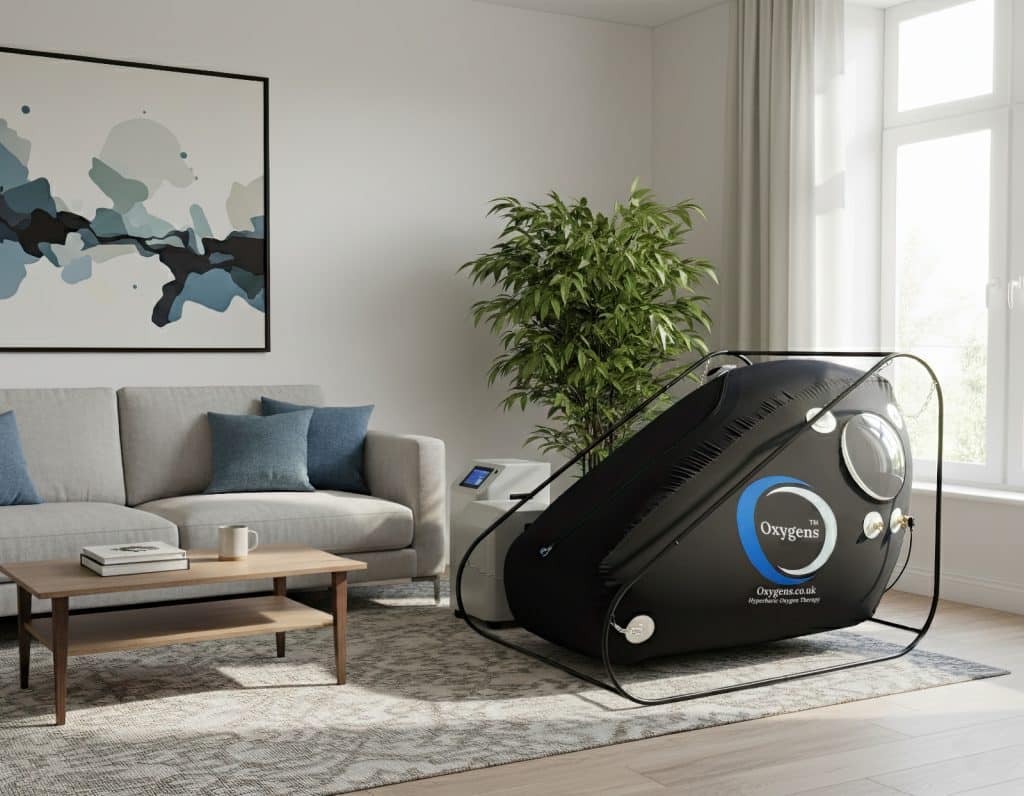Our soft hyperbaric chambers are built to be simple, safe, and easy to look after. To our knowledge, no fires have ever been documented inside soft-shell, air-pressurised chambers that use concentrators.
Even so, we stick to rigorous UK HSE guidance and relevant BS/EN standards for your peace of mind. With correct use and basic house rules, the situations that could cause a fire are effectively removed.
Fire safety, made simple
-
Pressurised with normal room air (not oxygen): Our soft, single-occupant chambers operate up to 1.5 ATA using filtered room air. Oxygen is supplied only to the user’s mask from a concentrator—it isn’t fed into the chamber volume. While a small amount of oxygen can escape around the mask, the chamber is constantly vented and refreshed, so it does not become oxygen-enriched. This design significantly reduces the fire risk associated with oxygen-rich environments—alongside the usual commonsense rules (use in a well ventilated room, no smoking, open flames, heaters, or aerosols near the chamber).
-
Quick to exit: The zip entry opens quickly while the chamber depressurises through its relief valves, so you can typically step out in about a minute. A quick-release control is also fitted for rapid, controlled depressurisation when required.
-
No built-in deluge required: Built-in fire-suppression systems apply to large, hospital (multiplace) chambers. Soft, single-occupancy units don’t require them; standard room-level fire protection and a simple fire-risk check are appropriate.
Why our triple-valve system matters for fire safety
-
Guaranteed depressurisation, even if something fails: Only one pressure-relief valve is needed to vent the chamber; the extra two are automatic fail-safes. In an emergency (e.g., heat/smoke nearby), the chamber will still depressurise and open quickly even if a valve is blocked or damaged.
-
Fast, predictable exit: Reliable venting drops the pressure gently and consistently, so the zip opens easily and you can get out fast without fighting against pressure.
-
No power required: Relief valves are passive (mechanical), so they keep working during a power cut—exactly the situation where the concentrator has already shut down and oxygen flow has stopped.
-
Keeps air moving: Continuous venting maintains airflow through the chamber, helping prevent any oxygen build-up around the mask area and supporting the “stop oxygen and exit” fire protocol.
Bottom line: the triple-valve design doesn’t “put out” a fire, but it ensures you can always depressurise and exit quickly and safely, which is the right fire response for soft, single-occupant chambers.
EMC & Fire Safety: why the electrics matter
EMC (Electromagnetic Compatibility) keeps the chamber’s electrics quiet, cool and predictable—which directly supports fire prevention and overall safety.
-
Fewer ignition risks: Clean, well-behaved power draw helps avoid hot plugs, cable overheating and nuisance arcing—common starters of electrical fires.
-
Safety features that stay reliable: Immunity to electrical “noise” means alarms, interlocks and the concentrator’s thermal cut-out work as intended, shutting off oxygen if there’s a fault or heat.
-
Stable around other kit: Low emissions and high immunity mean the chamber won’t misbehave near Wi-Fi, phones, chargers or clinic equipment.
Standards we meet (and why that matters):
-
BS EN IEC 55014-1:2021 — Low emissions, so your chamber won’t interfere with nearby devices or safety systems.
-
BS EN IEC 55014-2:2021 — High immunity, so safety controls keep working even around static or radio signals.
-
BS EN IEC 61000-3-2:2019/A1:2021 — Controls harmonic currents for cooler sockets and steadier performance.
-
BS EN 61000-3-3:2013/A1:2019/A2:2021 — Limits voltage dips/flicker, protecting home/clinic wiring on standard 13A sockets.
Bottom line: Good EMC = fewer sparks and heat build-ups, plus safety systems that respond exactly when you need them.
-
How we keep oxygen levels safe
-
The chamber atmosphere stays close to normal room air and is constantly vented.
-
Oxygen comes from a concentrator to your mask, not into the chamber space—so there’s no “oxygen-rich chamber” to worry about.
-
If there’s a power cut or fault, oxygen delivery stops automatically and the chamber depressurises safely through the valves.
Thermal cut-out: an extra safeguard
Your oxygen concentrator continuously monitors its internal temperature. If it overheats—say from a nearby heat source or blocked vents—the thermal cut-out trips, shutting down oxygen production and stopping flow to the mask (often with an alarm). This removes the high-oxygen stream that could intensify flames, prevents further enrichment around tubing, and lets the chamber continue to vent and decompress while you remove the mask and exit. The unit won’t restart until it has cooled and been safely reset.
Easy maintenance (weekly hoover, no chemicals)
-
Weekly hoover: Vacuum around and under the chamber/concentrator to keep dust away from air inlets.
-
Gentle cleaning only: Wipe soft surfaces and windows with a mild, non-abrasive, non-alcohol cleaner or a damp microfibre cloth. Avoid solvents, bleach and strong sprays.
-
Quick glance checks: Look over zips and hoses; a soft hiss from relief valves at pressure is normal.
-
Filters: Keep concentrator/compressor inlets clear; clean/replace filters as per the user manual.
-
Annual service: Book a yearly inspection to check seals, valves, hoses and gauges and refresh consumables.
In short
-
Fires are extremely rare in soft shell chambers that use concentrators and are preventable with proper use.
-
Soft shells are air-pressurised, quick to exit, and don’t need built-in deluge.
-
Oxygen is mask-only from a concentrator; airflow is constant and vented.
-
Maintenance is light: weekly hoover, gentle cleaning, and an annual check.

